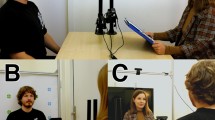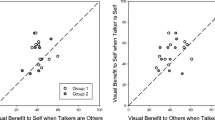Abstract
Auditory prominence is defined as when an acoustic segment is made salient in its context. Prominence is one of the prosodic functions that has been shown to be strongly correlated with facial movements. In this work, we investigate the effects of facial prominence cues, in terms of gestures, when synthesized on animated talking heads. In the first study, a speech intelligibility experiment is conducted, speech quality is acoustically degraded and the fundamental frequency is removed from the signal, then the speech is presented to 12 subjects through a lip synchronized talking head carrying head-nods and eyebrows raise gestures, which are synchronized with the auditory prominence. The experiment shows that presenting prominence as facial gestures significantly increases speech intelligibility compared to when these gestures are randomly added to speech. We also present a follow-up study examining the perception of the behavior of the talking heads when gestures are added over pitch accents. Using eye-gaze tracking technology and questionnaires on 10 moderately hearing impaired subjects, the results of the gaze data show that users look at the face in a similar fashion to when they look at a natural face when gestures are coupled with pitch accents opposed to when the face carries no gestures. From the questionnaires, the results also show that these gestures significantly increase the naturalness and the understanding of the talking head.
Similar content being viewed by others
References
McGurk H, MacDonald J (1976) Hearing lips and seeing voices
Summerfield Q (1992) Lipreading and audio-visual speech perception. Philos Trans Biol Sci 335(1273):71–78
Cave C, Guaïtella I, Bertrand R, Santi S, Harlay F, Espesser R (1996) About the relationship between eyebrow movements and Fo variations. In: Proc of the fourth international conference on spoken language, vol 4
Munhall K, Jones J, Callan D, Kuratate T, Vatikiotis-Bateson E (2004) Head movement improves auditory speech perception. Psychol Sci 15(2):133–137
Davis C, Kim J (2006) Audio-visual speech perception off the top of the head. Cognition 100(3):21–31
Cvejic E, Kim J, Davis C (2010) Prosody off the top of the head: Prosodic contrasts can be discriminated by head motion. Speech Commun 52
Terken J (1991) Fundamental frequency and perceived prominence of accented syllables. J Acoust Soc Am 89:1768
Gundel J (1999) On different kinds of focus. In: Focus: linguistic, cognitive, and computational perspectives, pp 293–305
Grice M, Savino M (1997) Can pitch accent type convey information status in yes-no questions. In: Proc of the workshop sponsored by the association for computational linguistics, pp 29–38
Granström B, House D (2005) Audiovisual representation of prosody in expressive speech communication. Speech Commun 46(3–4):473–484
Beskow J, Granström B, House D (2006) Visual correlates to prominence in several expressive modes. In: Proc of the ninth international conference on spoken language processing
House D, Beskow J, Granström B (2001) Timing and interaction of visual cues for prominence in audiovisual speech perception. In: Proc of the seventh European conference on speech communication and technology
Swerts M, Krahmer E (2006) The importance of different facial areas for signalling visual prominence. In: Proc of the ninth international conference on spoken language processing
Krahmer E, Swerts M (2007) The effects of visual beats on prosodic prominence: Acoustic analyses, auditory perception and visual perception. J Mem Lang 57(3):396–414
Dohen M, Lœvenbruck H (2009) Interaction of audition and vision for the perception of prosodic contrastive focus. Lang Speech 52(2–3):177
Dohen M, Lcevenbruck H, Hill H (2009) Recognizing prosody from the lips: is it possible to extract prosodic focus. In: Visual speech recognition: lip segmentation and mapping, p 416
Streefkerk B, Pols L, Bosch L (1999) Acoustical features as predictors for prominence in read aloud Dutch sentences used in ANN’s. In: Sixth European conference on speech communication and technology, Citeseer
Fant G, Kruckenberg A, Nord L (1991) Durational correlates of stress in Swedish, French, and English. J Phon 19(3–4):351–365
Bruce G (1977) Swedish word accents in sentence perspective. LiberLäromedel/Gleerup, Malmo
Gussenhoven C, Bruce G (1999) Word prosody and intonation. In: Empirical approaches to language typology, pp 233–272
Heldner M, Strangert E (2001) Temporal effects of focus in Swedish. J Phon 29(3):329–361
Fant G, Kruckenberg A, Liljencrants J, Hertegård S (2000) Acoustic phonetic studies of prominence in Swedish. KTH TMH-QPSR 2(3):2000
Fant G, Kruckenberg A (1994) Notes on stress and word accent in Swedish. In: Proceedings of the international symposium on prosody, 18 September 1994, Yokohama, pp 2–3
Krahmer E, Swerts M (2004) More about brows: a cross-linguistic study via analysis-by-synthesis. In: From brows to trust: evaluating embodied conversational agents, pp 191–216
Massaro D (1998) Perceiving talking faces: from speech perception to a behavioral principle. MIT Press, Cambridge
Agelfors E, Beskow J, Dahlquist M, Granström B, Lundeberg M, Spens K-E, Öhman T (1998) Synthetic faces as a lipreading support. In: Proceedings of ICSLP’98
Salvi G, Beskow J, Al Moubayed S, Granström B (2009) Synface—speech-driven facial animation for virtual speech-reading support. J Audio Speech Music Process 2009
Beskow J (1995) Rule-based visual speech synthesis. In: Proc of the fourth European conference on speech communication and technology
Sjölander K (2003) An HMM-based system for automatic segmentation and alignment of speech. In: Proceedings of fonetik, pp 93–96
Beskow J (2004) Trainable articulatory control models for visual speech synthesis. Int J Speech Technol 7(4):335–349
Shannon R, Zeng F, Kamath V, Wygonski J, Ekelid M (1995) Speech recognition with primarily temporal cues. Science 270(5234):303
Fant G, Kruckenberg A, Nord L (1991) Durational correlates of stress in Swedish, French and English. J Phon 19(1991):351–365
Heldner M, Strangert E (2001) Temporal effects of focus in Swedish. J Phon 29:329–361
Moubayed S Al, Ananthakrishnan G, Enflo L (2010) Automatic prominence classification in Swedish. In: Proceedings of prosodic prominence: perceptual and automatic identification workshop, Chicago, USA
Swerts M, Krahmer E (2004) Congruent and incongruent audiovisual cues to prominence. In: Proc of speech prosody
de Cheveigne A, Kawahara H (2002) YIN, a fundamental frequency estimator for speech and musicy. J Acoust Soc Am 111:1917
Al Moubayed S, Beskow J, Oster A-M, Salvi G, Granström B, van Son N, Ormel E (2009) Virtual speech reading support for hard of hearing in a domestic multi-media setting. In: Proceedings of interspeech 2009
Poggi I, Pelachaud C, De Rosisc F (2000) Eye communication in a conversational 3D synthetic agent. AI Commun 13(3):169–181
Ekman P (1979) About brows: Emotional and conversational signals. In: Human ethology: claims and limits of a new discipline: contributions to the colloquium, pp 169–248
Cassell J, Pelachaud C, Badler N, Steedman M, Achorn B, Becket T, Douville B, Prevost S, Stone M (1994) Animated conversation: rule-based generation of facial expression, gesture & spoken intonation for multiple conversational agents. In: Proceedings of the 21st annual conference on computer graphics and interactive techniques, pp 413–420
Raidt S, Bailly G, Elisei F (2007) Analyzing and modeling gaze during face-to-face interaction. In: Proceedings of the international conference on auditory-visual speech processing (AVSP 2007)
Vatikiotis-Bateson E, Eigsti I, Yano S, Munhall K (1998) Eye movement of perceivers during audiovisual speech perception. Percept Psychophys 60(6):926–940
Paré M, Richler R, ten Hove M, Munhall K (2003) Gaze behavior in audiovisual speech perception: the influence of ocular fixations on the McGurk effect. Percept Psychophys 65(4):553
Cutler A, Otake T (1999) Pitch accent in spoken-word recognition in Japanese. J Acoust Soc Am 105:1877
van Wassenhove V, Grant K, Poeppel D (2005) Visual speech speeds up the neural processing of auditory speech. Proc Nat Acad Sci 102(4):1181
Author information
Authors and Affiliations
Corresponding author
Rights and permissions
About this article
Cite this article
Al Moubayed, S., Beskow, J. & Granström, B. Auditory visual prominence. J Multimodal User Interfaces 3, 299–309 (2009). https://doi.org/10.1007/s12193-010-0054-0
Received:
Accepted:
Published:
Issue Date:
DOI: https://doi.org/10.1007/s12193-010-0054-0




